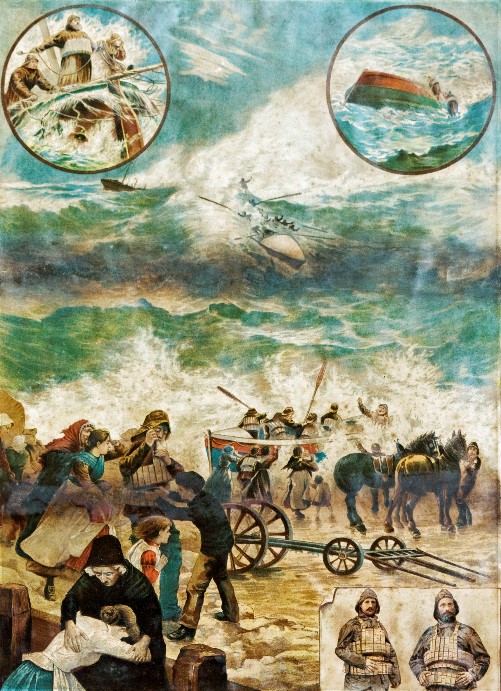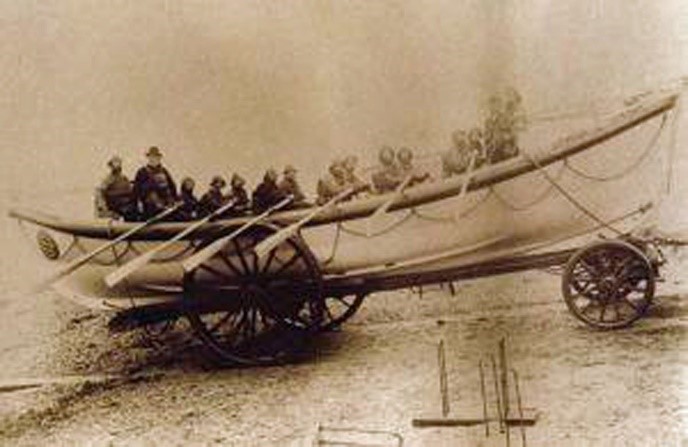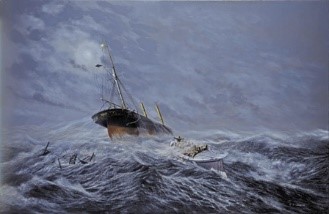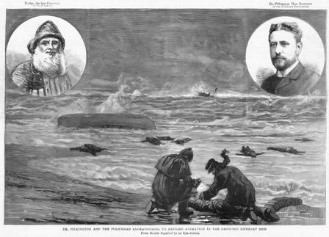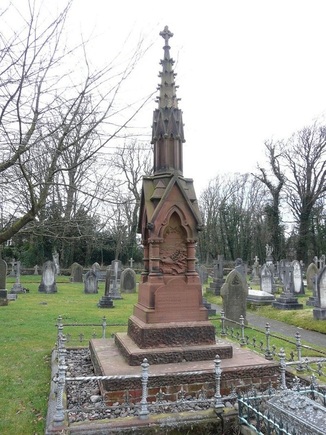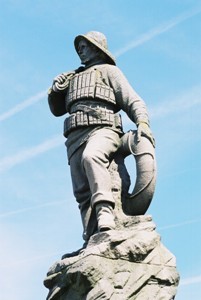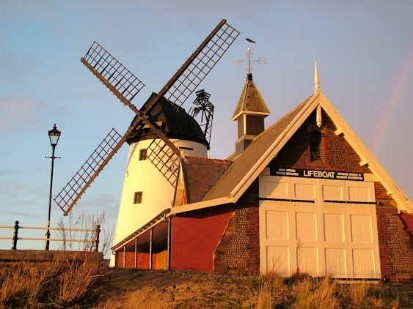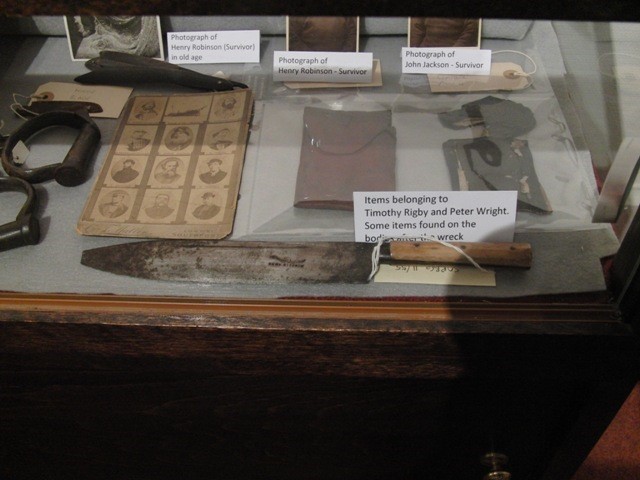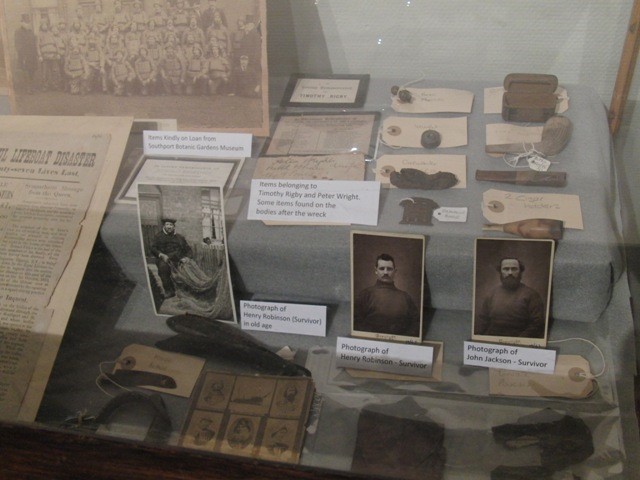The Mexico Disaster of 1886
|
Research by Jacqueline Arundel and Marjorie Gregson
|
|
RNLI History 1886: Southport and St Annes lifeboats disaster
|
'The Mexico’ Disaster of 1886, Appeal
chromolithograph size not known acc. no. 249 unknown acquisition method Nothing was known of the artist until early 2022 when a submission was received on our contact page from Robert Briggs, who owns a framed copy of this poster which has been enhanced with gouache. He was of the opinion that few of the posters have survived as so far he has only located ours which, like his, is framed with the poem, The Warriors of the Sea, a five stanza poem by writer and theatre critic, Clement Scott 1841-1904, published in 'Punch' on 25 December 1886 - see below for final verse. He named the artist as A E Forrestier'; further research has led to Sir Amedee Forestier 1845-1930, an Anglo-French artist and illustrator. His engraving entitled To the Rescue, Manning the Life-boat, which is used in the lower left, appeared in 'The Ilustrated London News' on 28 November 1885, the year before the disaster. So knowing the poster was a composite picture led to further research. On 18 December 1886 a double page engraving was published in 'The Illustrated News and Graphic' entitled 'The Life-Boat Disaster in Last Week's Gale: One of Two Life-Boats Capsized in Attempting to Save the Crew of the Barque Mexico, on the Lancashire Coast. The artist, Charles Napier Hemy 1841-1917, was a a British artist and best known for his marine paintings. This work appears in the upper right circle. The lower half of an engraving published in 'The Graphic' on 18 December 1886 entitled The Lifeboat when nearing the Wreck, Struck by the Sea. The Great Gale and Lifeboat Disaster at Southport, Lancashire was used below the circles. Pictured in the bottom right are the two surviving members of the lifeboat from Southport, the Eliza Fernley, Harry Robinson and John Jackson, taken from a commemorative postcard. |
|
This rescue remains the worst loss of crew in a single incident in RNLI history and was viewed as a national disaster across Victorian England.
The Mexico, a 400 ton Hamburg barque, left Liverpool on 5 December 1886 bound for Guayaquil, Ecuador. Four days later she was caught in a violent gale and amidst heavy seas and snow showers she ran aground on the perilous sandbanks in the Ribble Estuary near Southport. Lifeboats were launched from Lytham, St Annes and Southport to rescue the stranded crew. Eliza Fernley from Southport and Laura Janet from St Annes were the first lifeboats to launch. Tragically, they both capsized during the rescue attempt and 27 of the 29 crew were drowned. A third lifeboat, Charles Biggs, launched on its maiden rescue, saved the Mexico’s 12 crew members. The Rescue Southport’s Eliza Fernley was the first lifeboat to be launched in response to the Mexico’s distress signals. As the Eliza Fernley reached the stricken vessel the rough seas and terrible gale capsized her. Only 2 of the 16 crew survived, Henry Robinson and John Jackson, who had been trapped under the boat after it overturned. They survived by clinging to the keel of the boat and swimming back to shore to raise the alarm. Two hours later the lifeboat was found washed up at Birkdale. Twenty minutes after the Eliza Fernley was called out, the Laura Janet from St Annes was launched. It never reached the Mexico and was found ashore the following morning – the entire crew had been lost. As there were no survivors it has never been clear exactly what happened to the Laura Janet. A third lifeboat, the Charles Biggs, was launched on her maiden rescue to assist the crew of the Mexico. After shattering 3 oars and being filled numerous times with water, the Lytham crew, in their new vessel, miraculously reached the stricken ship. By this point the Mexico had settled on her beam ends and her crew had strapped themselves to the rigging. The Charles Biggs rowed for a mile and a half to reach the Mexico and successfully rescued all 12 crew members. The Aftermath
This was the worst disaster in RNLI history; 27 men lost, leaving 16 widows and 50 children without fathers. A public appeal was launched to support those widowed and orphaned by the tragedy. Donations were received from Queen Victoria and Kaiser Wilhelm. The money raised also went towards memorials to commemorate the lifeboatmen lost at sea. Six memorials were erected, including on the promenade at St Annes, Duke Street Cemetery in Southport and St Cuthbert’s Church in Lytham, which still stands today. |
Commemoration
On 23 May 1888 the Lifeboat Monument was unveiled in St Annes to commemorate the bravery of these crews. An 1891 appeal, bolstered by the press in the north-east of England, raised £10,000 in just two weeks. In the same year a local businessman, Sir Charles Macara, and his wife, Marion, organised Lifeboat Saturday, the first recorded charity street collection. It featured a parade of bands, floats and lifeboats through the streets of Manchester and raised over £5,000. Marion Macara formed a Ladies’ Guild to help organise the street collection and within 10 years more than 40 Ladies’ Guilds had sprung up around Britain and Ireland, helping to double the RNLI’s income. Next door to Lytham Windmill is The Old Lytham Lifeboat House; constructed largely of cobblestones which are a feature of many Lytham buildings. The Shipwrecked Mariners Society, later replaced by the RNLI, first stationed a lifeboat at Lytham in 1851 and the twelve lifeboats that have been stationed in Lytham over the years have saved hundreds of lives.
For many years the Old Lifeboat House was a museum, telling the story of Lytham lifeboats from 1851 to the present day. The Grade II listed building closed in 2004 but reopened to the public after over 10 years of closure. The main exhibit is a Victorian Pulling and Sailing Lifeboat named Chapman that has recently been restored to a very high level. The theme of the museum is the Great Lifeboat Disaster of 1886. The museum was organised by Lytham Heritage Group who already managed the adjacent museum inside Lytham Windmill. The Group worked in close partnership with Lytham St Annes RNLI Heritage Team and Fylde Borough Council. THE CREW OF THE LAURA JANET
lost on the night of 9/10 December 1886 William Johnson, 35 (Coxswain) Charles Tims, 43 (2nd Coxswain) Oliver Hodson, 39 (Bowman) James Bonney, 21 Nicholas Parkinson, 22 Richard Fisher, 45 James Johnson, 45 John P Wignall 22 Reuben Tims, 30 Thomas Parkinson 28, Thomas Bonney, 35 James Dobson, 23 James Harrison, 19 THE CREW OF THE SOUTHPORT LIFEBOAT ELIZA FERNLEY lost on the night of 9/10 December 1886 Charles Hodge (Coxswain) Ralph Peters (2nd Coxswain) Benjamin Peters Peter Wright Thomas Spencer Thomas Rigby Timothy Rigby Harry Rigby Thomas Jackson Peter Jackson John Ball Henry Hodge John Robinson Richard Robinson The above details were taken from: On Those Infernal Ribble Banks - A Record of Lifesaving by the Lifeboats of Lytham St Annes by David Forshaw, 2nd edition, published for and on behalf of Lytham St Annes RNLI Station by Great Northern Publishing, 2006 . The poem The Warriors of the Sea is reproduced in full in the above book. The final verse of The Warriors of the Sea When in dark nights of winter, fierce storms of wind and rain Howl round the cosy homestead, and lash the window pane; When over hill and treetop we hear the tempest roar And hurricanes go sweeping on from valley to the shore; And those we love the best on earth are gathered in our homes, Think of the sailors round our coasts who, braving sleet and snow, Leave sweethearts, wives and little ones when duty bids them go. Think of our sea-girt Island, a harbour where alone No Englishman to save a life has failed to risk his own: Then when the storms howls loudest, pray of your charity That God will bless the lifeboat, and the Warriors of the Sea. |
